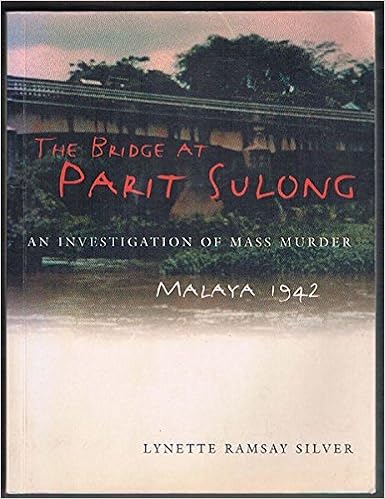This is an article reproduced from the West Australian 22/01/2012
My grand uncle William Campbell was one of the men massacred at Parit Sulong. He left a widow at home in Australia who never came to terms with the manner of his death and a young boy who grew up not knowing his father. They did not know the full details, and the information was sealed under the secrecy act. Was there an active coverup?
 pub 2004
pub 2004
This January 2020, will be the 78th Anniversary Rest in Peace Uncle Bill .
Drains reveal war massacre secret
Today marks the 70th anniversary of a massacre of Australian prisoners at the Malayan village of Parit Sulong during World War II.
It is an atrocity that was lost to public consciousness for many decades. The publication in 2005 of The Bridge at Parit Sulong: An Investigation of Mass Murder, based on research by Sydney historian Lynette Silver, retrieved it from the mists of history.
Not only were the appalling events brought to public awareness again, but Silver also solved an enduring mystery underlying the atrocity.
Although Japanese general Nishimura Takuma, who ordered the killings, was hanged for war crimes – one of only two survivors of the massacre, Lt Ben Hackney, supplied a deposition against him – no traces of the victims’ remains were found.
Troops of the Australian Imperial Forces captured at Parit Sulong on January 22, 1942, were involved in the fierce battle around the town of Muar.
It was part of a desperate fighting retreat by Allied forces during the Malayan campaign.
Though depleted and greatly outnumbered by 10,000 Japanese Imperial Guards, the Allied forces – of about 4000 Australians, with a small Indian Army group – inflicted heavy casualties on them. However, pushed back to the hamlet of Parit Sulong, the Australians were surrounded.
No relief would be forthcoming. Refusing to surrender, Lt-Col Charles Anderson, who was awarded the Victoria Cross for his role in the fighting, gave the order – every man for himself.
It was hoped at least some of the troops would make it through the jungle swamps back to Allied lines. But 110 badly wounded Australians and 35 Indian soldiers had to be left behind in trucks at the bridge.
It was expected they would receive Red Cross protection.
Instead, the Japanese forced them out of the vehicles, tied them together, bayoneted and machine-gunned them. Petrol was poured over the dead and dying men and they were set on fire.
“Post-war, not a single trace of any of these victims was found,” Silver said.
“As the Japanese claimed they had been cremated, no further investigation in regard to the remains was undertaken.”
Knowing it was impossible to cremate the bodies to ash, Silver was puzzled by the contradictory stories she encountered about the fate of the remains as she researched the history of the battle.
In addition to the cremation story, there was testimony that charred bodies were disposed of in a mass grave. Others said the victims were thrown in the river.
To complicate matters, survivor Lt Hackney saw no sign at all of the battle or massacre when he passed through the village after recapture.
Then, in 2003, in an upgrading of the Parit Sulong bridge, human bones were found.
Later, an Australian-Malaysian archaeological examination of the site was done through the Department of Defence’s Unrecovered War Casualties Unit.
However, this only deepened the mystery. Despite three weeks of sifting tonnes of dirt, no trace of the massacre was found.
“Indeed, the most remarkable feature of the excavation was there was nothing to indicate the area had been subjected to fierce fighting, or that large numbers of Allied troops and civilians had been killed there,” Silver said.
“Malaysian archaeologist Dr Stephen Chia remarked that he had never excavated a site with such potential that had yielded not a single archaeological find of any significance.”
Silver finally solved the puzzle. The drains (or parits) in the area emptied at low tide. They made a perfect mass grave.
She was able to pinpoint that the “burial” had taken place on January 23. The bodies would have later washed out on the evening high tide.
“Any residual remains would soon be flushed by the monsoonal rain, which resulted in massive floods about two weeks later,” she said.